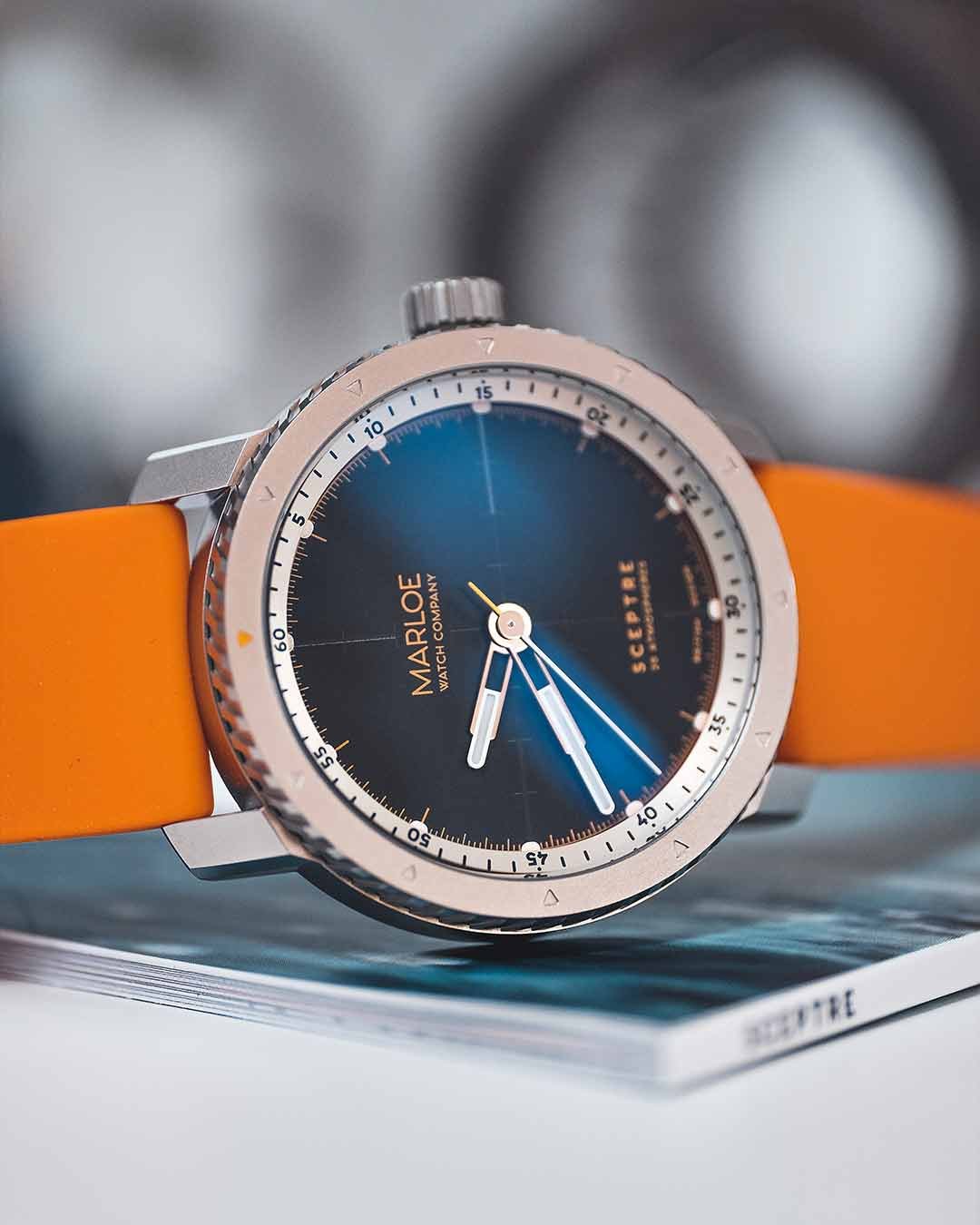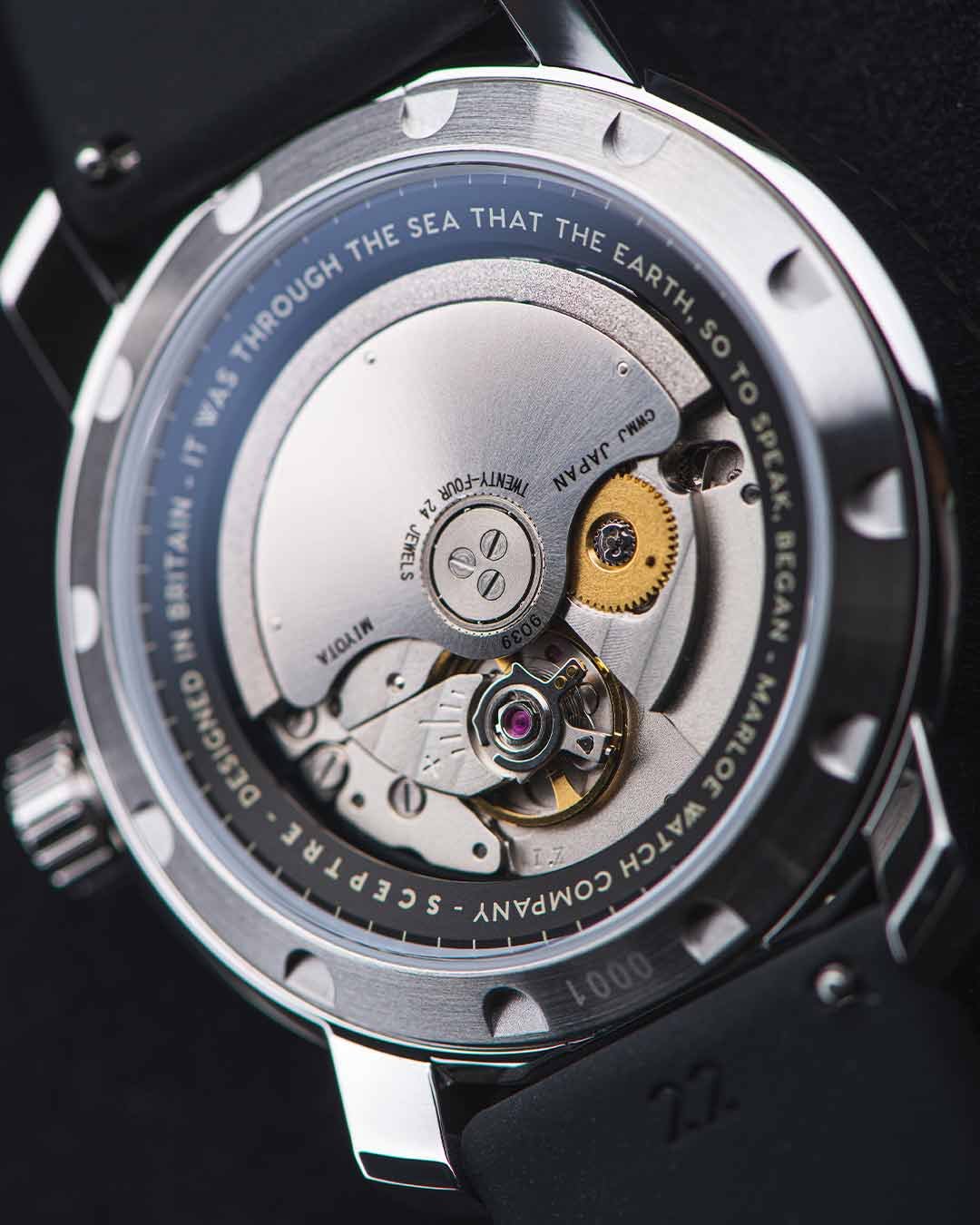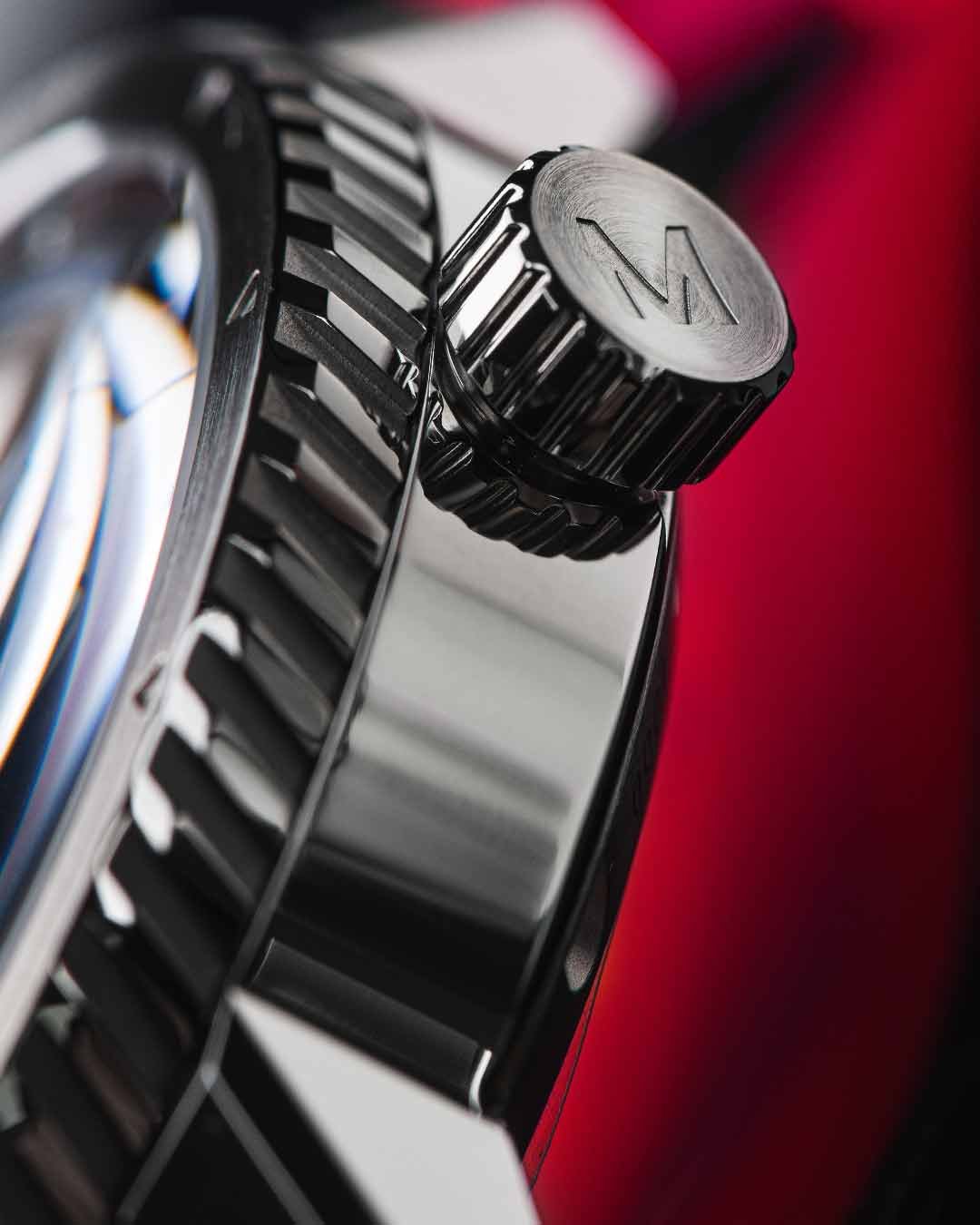
A NEW CONTENDER
Towards the end of 2021, Miyota introduced us to the developmental GMT movement they had been working on - a brand new, Japanese made ‘true’ GMT calibre that would sit alongside the fantastic 9039, a movement we’ve used in many of our most popular watches.
Once the palpable excitement had subsided we got straight to the drawing board; we would develop a GMT watch using this Miyota 9075 automatic movement and, thereby, become one of the first in the world to do so. The pressure was on.
The design, however, was quick and assured - calling on our experience over the past 8 years we knew exactly what we wanted to achieve with this watch. It’s comprehensively furnished with the very best components, materials, finishes, proportions and mechanics. We’ve spent a long time developing the GMT case to sit beautifully on the wrist and almost disappear, letting the box-profile Sapphire crystal do its work, creating a remarkably open and bright dial through which to view the aero hands, date complication, applied indices, dial textures, multiple layers of construction and of course, the GMT hand.
The GMT marks a sea change in our attitudes to watch design and execution. From the moment you attach it to your wrist to the lifetime of service it will provide, we think you’ll agree it’s time well spent.
To the future and whatever it may hold.
OLIVER GOFFE - OPERATIONS & MARKETING
There’s a reason that Marloe is regarded as the most customer-loyal and friendly watch company around. It’s because of Oliver’s unwavering commitment to doing things the right way; he could be called a perfectionist, but we prefer to call him immensely pernickety.
GORDON FRASER - CREATIVE & PRODUCTION
Design through immersion is what makes each Marloe watch unique. A professional empathiser, Gordon highlights the spirit of pioneering, human endeavour and love of discovery in everything we do. A patriotic Scotsman, lover of pretzels and whisky. Maybe jazz too.

MORE THAN ONE?
A lot has been written about GMT watches and why they’re so desirable to own. It used to be the case that GMT watches were the pinnacle of watchland with only the most expensive models offering this revered GMT complication.
That fact remained true until very recently, for most Japanese movement manufacturers failed to offer such a beast - it was the job of the Swiss to offer GMT movements to the market. Of course, with Swiss manufacturing comes Swiss prices, and thus the GMT movement remained absent from our line-up. That would all change when first Seiko and then Miyota announced they were developing new GMT movements.
We’ve had close ties with Miyota for a long time and so it made sense to choose their calibre for our watch, but more than that, the Miyota GMT movement is what’s referred to as a ‘true’ GMT. What this means is that the main hour hand can jump in hour increments, forward or back, to change the ‘local’ time to whatever you fancy. The 24-hour GMT hand remains in place, slowly revolving around the dial showing your ‘home’ time.
The alternative GMT movement features a jumping 24-hour hand, with the main hour hand remaining in place; it’s easier to jump the hand that isn’t as obvious for referencing other time zones. This is termed an ‘office’ GMT.
We like the authenticity and connection to the history of the ‘true’ GMT watch, and Miyota’s premium automatic range features incredibly reliable movements, so the decision was an easy one.
Now, being Marloe, we weren’t satisfied with just keeping two time zones, so we engineered the ability to keep tabs on a third! That’s where the bi-directional bezel comes into play. By offering this third time-zone reference you’re able to move the bezel quickly to an appropriate position to see what time it is in another part of the world. Easy as that. Instructions on how to set the bezel, and the correct way of setting up your watch for daily use, come later in the manual.

BALANCED DESIGN
The design process of the GMT was relatively quick, mainly because we knew exactly what we wanted to create: a case design that built upon our learnings to deliver an eye-catching, comfortable, discreet and compact watch; a box-profile Sapphire crystal to bring as much light into the dial as possible; bold colours and uncomplicated dial design; textures and finishes that exude quality and craftsmanship; and an overall balanced and considered design.
We believe we’ve achieved it, for the GMT sings on the wrist. The case size is bold yet wears neatly, thanks to the short lug-to-lug dimension and the bezel shrinking the dial diameter. Light plays on the chamfered edge of the bezel with brushed textures diffusing the light just so, to make the case sparkle. The box Sapphire floods the dial with light, emphasising the sandpaper textured dial, as well as the various levels, angles and complexities within. Applied indices - polished, chamfered and filled with luminous compound - catch the revolving light and stand proud above the dial surface. Depth, dynamics and a feeling of completeness follow.
It’s a proud moment seeing the GMT design come to life, through many months of iterative improvements. What you see on your wrist today is the culmination of 8 years’ experience, and is a testament to dedication, perseverance and maturity in our designs.
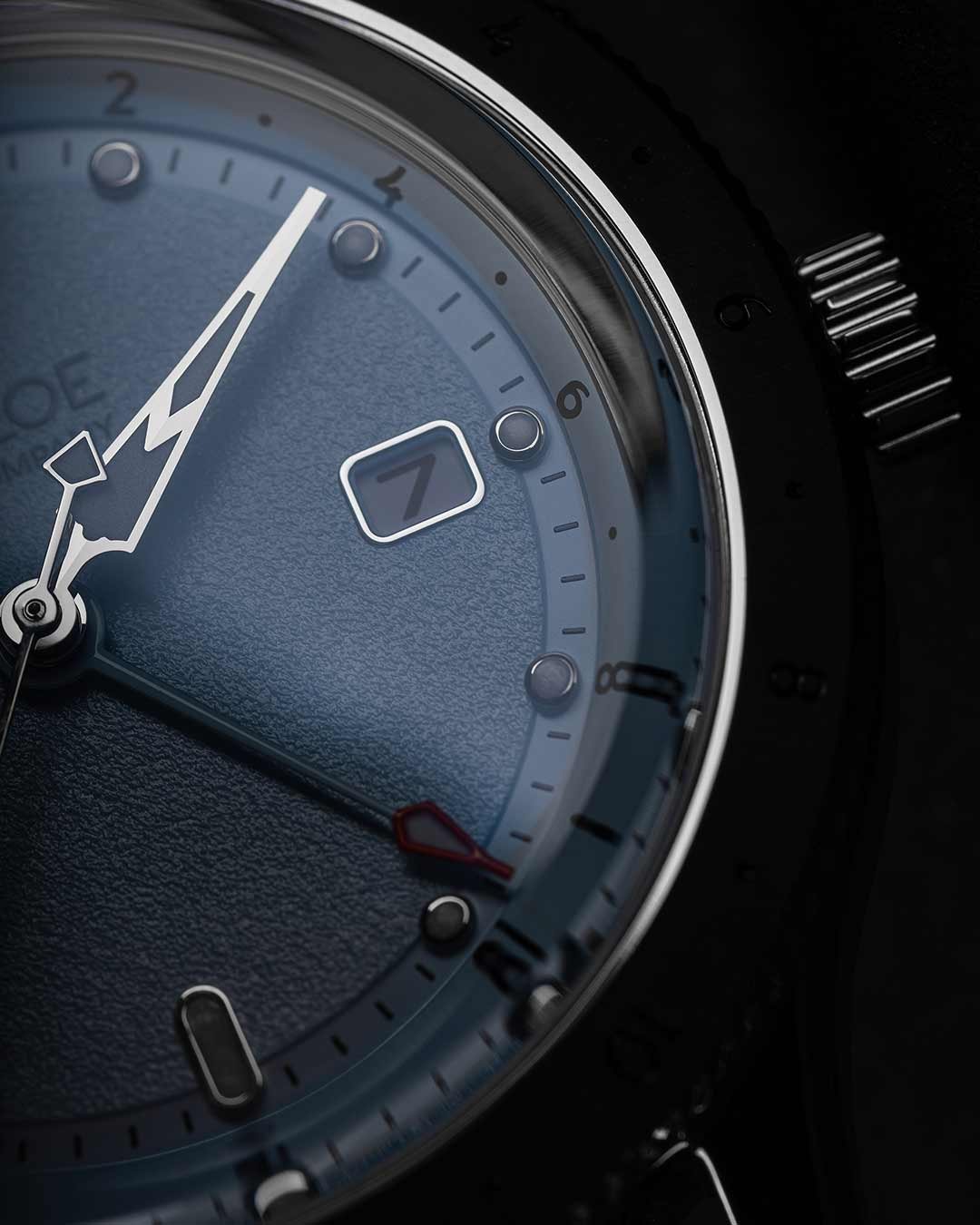
RELIABILITY
A new calibre release is often fraught with danger - there’s only so much testing that can be done before mass-market release commences. In the past, we have been wary of jumping on new movements until they have an established track record of success.
However, the Miyota 9075 is not a new calibre, technically speaking, for it builds upon the incredible base of the 9039 automatic movement. We have used the 9039 in thousands of Marloe watches now and the reliability rate has been nothing short of astounding. In fact, it delights us that the Miyota 9039 has a better reliability rate than our Swiss movements. Yes, it’s surprising to us too.
As such, even though the 9075 is a new-to-market calibre with the ‘true’ GMT functionality built in, it’s still the beloved workhorse that we’ve come to cherish and respect. It features the same functions too; hacking, shock protection and wonderful accuracy, as well as the automatic rotor to keep the power reserve charged as you wear it, with the addition of a date complication for extra functionality.
And although we may be amongst the first to adopt this new movement, we’re quite confident that the 9075 will continue the superb legacy that Miyota have developed over the years for Swiss-beating movements.

VALUE PROPOSITION
There’s no more overused term in watchland than ‘value proposition’. It encapsulates the bang-for-buck effect sought by a lot of enthusiasts in any new purchase. We’ve tended to avoid such terminology because we truly believe that every single one of our watches offers you the very best craftsmanship, reliability, and, most importantly, value for money.
That said, the GMT is the epitome of ‘value proposition’. Not only does it hold the only non-Swiss ‘true’ GMT movement on the market, but we’ve built a bespoke frame around that incredible calibre from 316L stainless steel, finished in two textures: mirror polished and vertically brushed. We’ve encased the dial and caseback in Sapphire, with the front enjoying the extremely complex-to-manufacture box Sapphire crystal, with AR coating both inside and out.
We’ve fitted a bi-directional, 48-click bezel, complete with etched and paint-filled numerals, luminous applied pip and dual textures for contrast. The crown is a perfectly proportioned 6.5mm diameter with exaggerated grip, and the whole caboodle comes in at an incredibly neat 42mm diameter, 10.95mm thickness and 47mm lug-to-lug. The GMT is a bit of a spec monster.

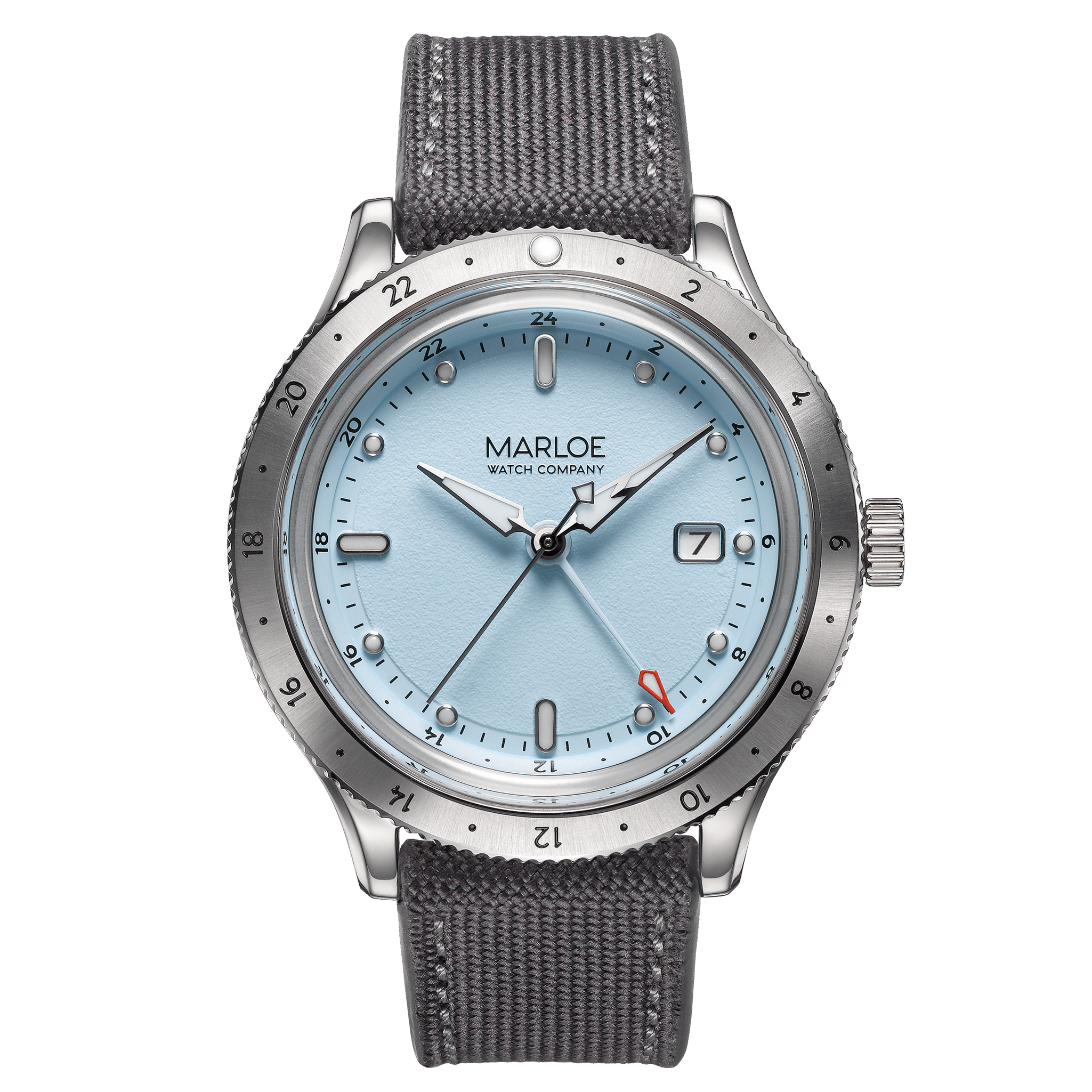
DAY
Bright, fresh and clear, the GMT Day dial is inspired by the light blue sky that breaks over a crisp Spring morning in Scotland. It’s not the deeper blue of Summer, but an airy, icy blue.
We’ve kept it simple in terms of colouring for the GMT dials and used textures and dial architecture to enhance the aesthetics. The centre of the GMT dial features a rough sandpaper texture that meets a smooth, chalky outer - these two textures are bridged by the applied hour indices.
The GMT 24-hour scale is printed on a chamfered internal ring that adds contrast and shade around the outer perimeter of the dial. Bold, black markings are printed for the angled GMT scale and the minute marks on the flat dial surface.
For the jet stream hands, we’ve applied a mirror-polish finish to the main hand set, allowing the profiled hour and minute hands to shine. The hairline seconds hand enjoys this polished finish too, with the GMT hand featuring a dial-matched stalk leading to a striking post-box red tip.
Luminous compound fills all the hands for low-light legibility; the running seconds hand is the only hand to feature a counterweight which has a small delta of luminescence. A rather spectacular presentation throughout.
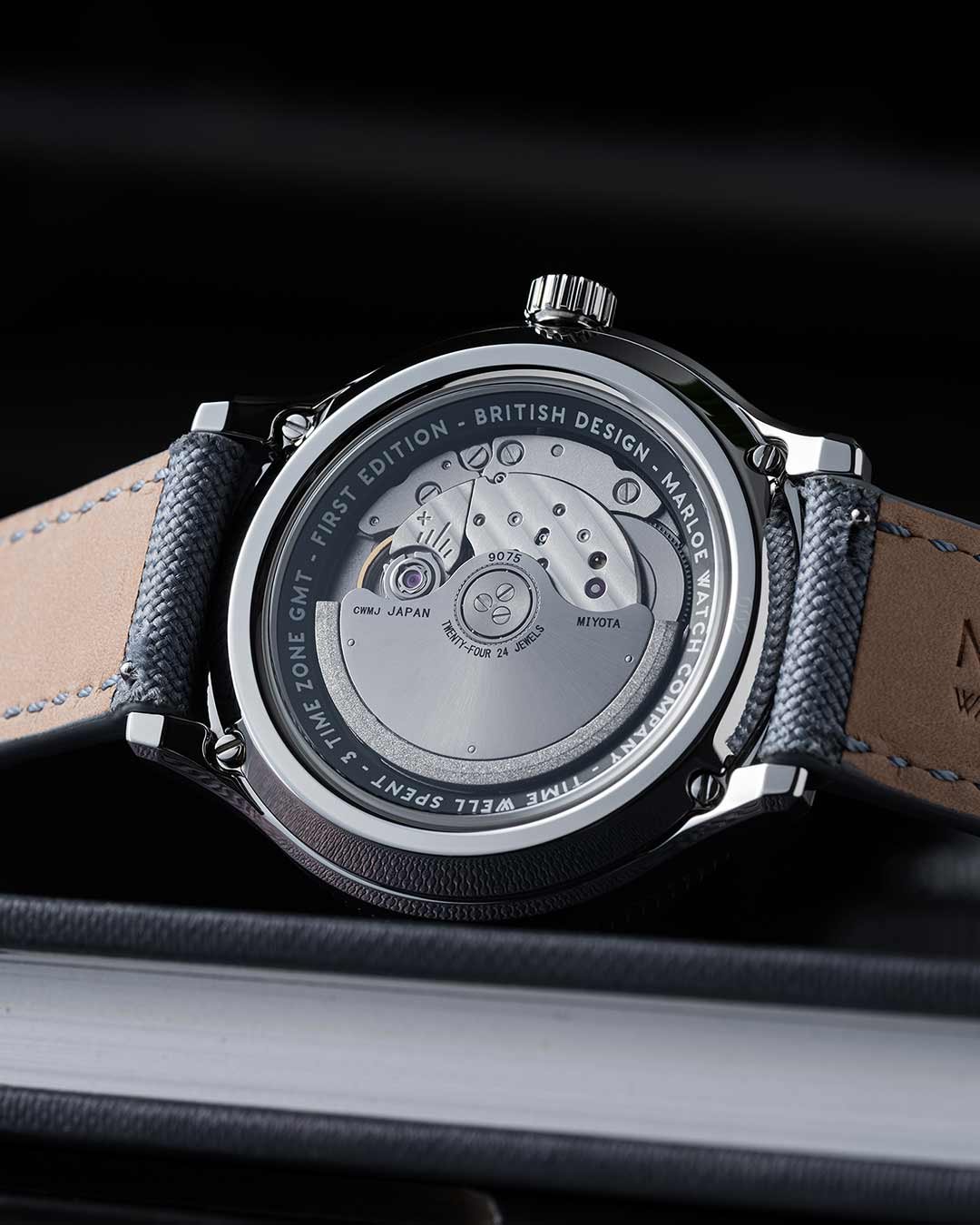

NIGHT
With the fading light we welcome the rich blue of night. Our GMT Night is not black, but a twilight blue - thick and dense, it feels infinite, and is the perfect backdrop upon which to mark our navigation.
The GMT Night features the same dial construction as the GMT Day, with the centre section of the main dial enjoying a rough sandpaper texture; here it resembles the rippling ocean surface moonlit from 30,000 feet.
Crisp white markings for the 24-hour scale on the chamfered internal bezel, and the main minute marks, stand out perfectly for maximum legibility. Beauty in simplicity.
The hands make a slight departure from those of the GMT Day, in that the running seconds hand is painted a fantastic, almost luminous orange. This orange appears on the GMT hand tip at the end of a stalk painted to match the dark blue of the dial - it disappears, leaving the floating orange delta revolving around the dial edge.
Balance is key in a watch dial, which is why we’ve taken great pains to balance the date window against the applied markings, framing the window in a polished, rounded rectangle that harmonises against the polished frames of the luminous hour blocks. Glancing at your wrist for the time has never been so distracting.
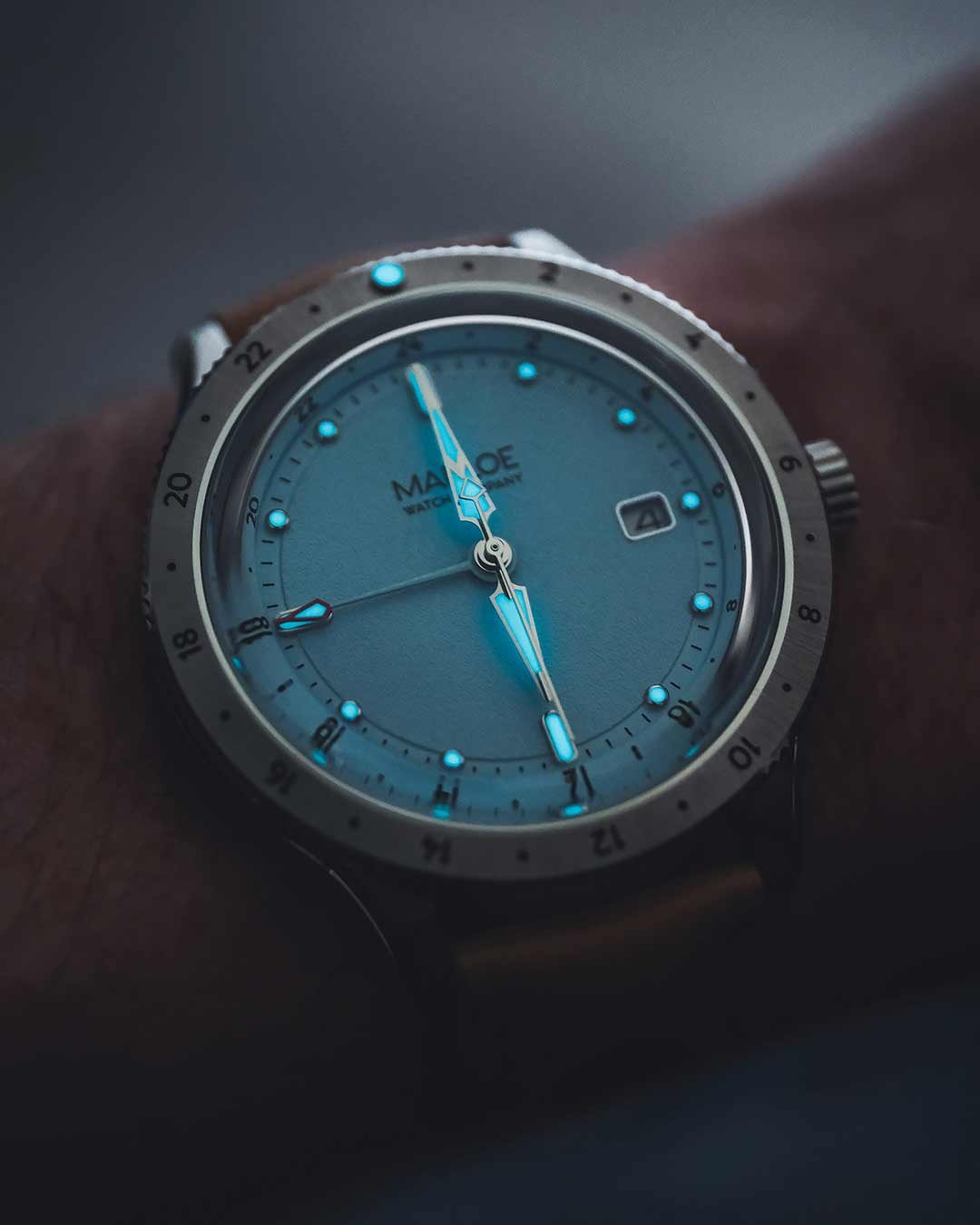
OPERATING THE GMT
CROWN POSITIONS
UNDERSTANDING THE MOVEMENT
The GMT has a 3-position crown for winding and time adjustment.
Position 1: Normal Position: The crown is sitting flush against the case ready to be wound. Once everything is set, this is the position your crown needs to be for normal operation and topping up the power reserve.
Position 2: Quick-Set Hour/Date: With the crown pulled out once from Position 1, the main hour hand can be set in hourly increments, forwards or backwards, to whichever hour you desire. The seconds hand will continue to move. In this position the date will also jump forwards or backwards when the hand crosses the 12 o’clock (midnight) position. By turning the hour hand in either direction for two full rotations, the date can be set quickly. Please note that unlike other date complications, the date can be set forwards and backwards at any time without damaging the date wheel.
Position 3: Minute and GMT Position: Pulling the crown fully out will engage the mechanism to set both the minute hand and the GMT hand. The seconds hand will cease to move (hacking function). Each hand will rotate smoothly around the dial without jumping. Once the minute and/or GMT hand has been set, push the crown fully back towards the case - the seconds hand will begin to move again, indicating that the watch is now running.
INITIAL SETUP
WHAT TO DO WHEN YOU FIRST GET YOUR GMT
Follow this guide to set your GMT watch properly.
Step 1 - Set ‘HOME’ time: Pull the crown fully out to Position 3. Turn the crown in either direction to set the GMT hand and the minute hand to the current time, using the chapter ring inside the crystal (24-hour scale) for the GMT hand only. Once these two hands are in position, click the crown in once, to Position 2. This sets up your ‘home’ time on the GMT scale, and the movement will begin running.
Step 2 - Set the date: Once the crown is in position 2, you can set the date by turning the crown, either forwards or backwards, advancing the main hour hand around the dial. Advancing past midnight will click the date over to the next. We suggest, if moving the date backwards, to continue to ‘yesterday’ and then advance forward just past midnight to today’s date. This will align the mechanics appropriately for Step 3. Keep the crown in the same position for Step 3.
Step 3 - Set the ‘LOCAL’ hour: When the date has clicked past midnight into the present day you can continue to jump the hour hand in hourly increments clockwise to the current hour, or whichever time zone you wish - this will be your ‘local’ time. If the local time is currently PM, make sure to rotate the hour hand past the midday point and into the second half of the day, otherwise the date will not advance at midnight as expected.
Step 4 - Set for normal operation: Once all that’s been done, push the crown fully into the case for normal operation to resume.
TIME ZONE 3
FOR THOSE OF EXTRA WORLDLY TREKKING
It might seem complicated at first, but it’ll soon make absolute sense, we promise! Once the time has been set up as per the previous page, you are now able to use that base to reference a third time-zone using the bezel. The main hour and minute hands are to be ignored for this exercise.
For time zones that are ahead of your ‘home’ time zone, align the chosen number to the 12 o’clock position. For +6 GMT you would align number 6 on the bezel to 12 o’clock. This will then allow you to quickly see, using the GMT hand and the two 24-hour scales (inner scale and bezel), what the time is in your chosen third time-zone - in this example, the time locally is 4pm (16:00) and the time in the third zone is 10pm (22:00).
For time zones that are behind your ‘home’ time zone, align the bezel pip to the time zone you seek using the internal 24-hour scale. For -6 GMT you would align the bezel pip to number 6 on the internal 24-hour scale. This will then allow you to quickly see, using the GMT hand and the two 24-hour scales (inner scale and bezel) what the time is in your third time-zone - in this example the time locally is 4pm (16:00) and the time in the third zone is 10am (10:00).
Remember - the GMT hand moves around the dial once every 24 hours, so you must only use the 24-hour scale when referencing different time zones. The main hour/minute hand and 12-hour clock scale does not apply when using the GMT hand and bezel references.
Do not panic - if you are still confused, head to our website where a video explanation will await you.

SPECIFICATIONS
-
42mm diameter x 12.65mm depth
22mm strap width
Dual-texture bespoke designed case w/screw down crown
Sapphire crystal with dual side anti-reflective coating
Multi-layer dial with applied indices & polished chamfer
Divider hand design
Hairline seconds hands w/counter-weight & arrow tip
Luminous hands and dial perimeter
76g
20 ATM
-
Miyota 9039 automatic mechanical movement
28,800 bph
24 jewels
Handwinding override capability
40+ hour power reserve
-10 ~ + 30 sec/day
Japanese Made
Hacking function
Parashock anti-shock
-
A mechanical movement, like a car engine, uses oils to lubricate the moving parts. Over time this fine grade of oil can become gloopy, causing your movement to lose accuracy. Every 4-5 years, think about having your watch cleaned and re-oiled by a professional - it’ll keep everything ticking along nicely.
The Sceptre enjoys a 2-year limited warranty which covers manufacturing defects. T&C - see our website.
